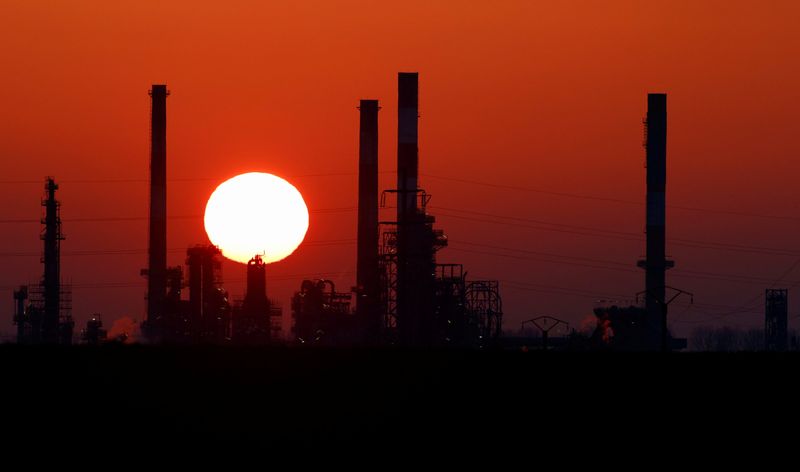Commodities
Oil set for weekly loss despite gain on OPEC+ output decision


© Reuters. FILE PHOTO: The sun sets behind the chimneys of the Total Grandpuits oil refinery, southeast of Paris, France, March 1, 2021. REUTERS/Christian Hartmann/File Photo
By Noah Browning
LONDON (Reuters) – Oil prices rose slightly on Friday after the OPEC+ group’s decision to keep its production policy unchanged, but benchmarks remained on track for weekly losses on China demand growth fears.
futures were up 27 cents, or 0.3%, at $78.97 a barrel by 1215 GMT and U.S. West Texas Intermediate crude futures gained 23 cents, or 0.3%, to $74.05.
The Brent benchmark had approached $85 a barrel in Monday trading.
Two OPEC+ sources said on Thursday that the group has kept its output policy unchanged and will decide in March whether to extend the voluntary oil production cuts in place for the first quarter.
The Organization of the Petroleum Exporting Countries (OPEC) and allies led by Russia, together known as OPEC+, has output cuts of 2.2 million barrels per day (bpd) in place for the first quarter, as announced in November.
“What has been already been made clear last year is that the reversal of those cuts will be gradual,” said UBS analyst Giovanni Staunovo, adding that the bank expects an extension into the second quarter.
Also supporting oil prices was the U.S. Federal Reserve’s decision to keep the benchmark overnight interest rate in the 5.25-5.50% range and comments by Fed Chair Jerome Powell, saying interest rates had peaked and would move lower in the coming months.
Lower interest rates would reduce consumer borrowing costs, which can boost economic growth and oil demand.
However, oil prices were still heading for weekly losses of about 5% after unsubstantiated reports of a ceasefire between Israel and Hamas capped gains and caused the contracts to settle more than 2% lower on Thursday.
Concern over China’s economic recovery continued to linger, with the International Monetary Fund on Friday forecasting that the country’s economic growth would slow to 4.6% in 2024 and decline further in the medium to about 3.5% in 2028.
Meanwhile, concern over shipping dragged on after a military spokesperson for the Iran-aligned Houthi group said on Thursday that attacks on shipping will persist until Israel’s “siege on the Gaza Strip is lifted”.
Commodities
Oil prices rise; U.S. crude inventories plunge, Russia-Ukraine truce eyed
Commodities
India’s Reliance to stop buying Venezuelan oil over US tariffs, sources say
Commodities
Oil prices climb on Venezuela supply worries

 Forex3 years ago
Forex3 years agoForex Today: the dollar is gaining strength amid gloomy sentiment at the start of the Fed’s week

 Forex3 years ago
Forex3 years agoUnbiased review of Pocket Option broker

 Forex3 years ago
Forex3 years agoDollar to pound sterling exchange rate today: Pound plummeted to its lowest since 1985

 Forex3 years ago
Forex3 years agoHow is the Australian dollar doing today?

 Cryptocurrency3 years ago
Cryptocurrency3 years agoWhat happened in the crypto market – current events today

 World3 years ago
World3 years agoWhy are modern video games an art form?

 Commodities3 years ago
Commodities3 years agoCopper continues to fall in price on expectations of lower demand in China

 Economy3 years ago
Economy3 years agoCrude oil tankers double in price due to EU anti-Russian sanctions



























